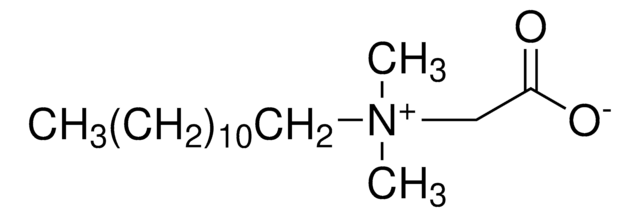H6883
3-(N,N-Dimethylpalmitylammonio)propanesulfonate
≥98% (TLC)
Synonyme(s) :
3-(N,N-Dimethylhexadecylammonio)propanesulfonate, 3-(Hexadecyldimethylammonio)propanesulfonate, 3-(Palmityldimethylammonio)propanesulfonate, Palmityl sulfobetaine, SB3-16
About This Item
Produits recommandés
Description
zwitterionic
Essai
≥98% (TLC)
Poids mol.
micellar avg mol wt 60,700
Nombre d'agrégation
155
Technique(s)
electrophoresis: suitable
mass spectrometry (MS): suitable
thin layer chromatography (TLC): suitable
Conductivité
≤10 μmho per cm at 24 °C (0.05 M aqueous solution)
CMC
0.01-0.06 mM (20-25°C)
Application(s)
cell analysis
Chaîne SMILES
CCCCCCCCCCCCCCCC[N+](C)(C)CCCS([O-])(=O)=O
InChI
1S/C21H45NO3S/c1-4-5-6-7-8-9-10-11-12-13-14-15-16-17-19-22(2,3)20-18-21-26(23,24)25/h4-21H2,1-3H3
Clé InChI
TUBRCQBRKJXJEA-UHFFFAOYSA-N
Vous recherchez des produits similaires ? Visite Guide de comparaison des produits
Catégories apparentées
Description générale
Application
Code de la classe de stockage
11 - Combustible Solids
Classe de danger pour l'eau (WGK)
WGK 3
Point d'éclair (°F)
230.0 °F - closed cup
Point d'éclair (°C)
110 °C - closed cup
Équipement de protection individuelle
dust mask type N95 (US), Eyeshields, Gloves
Faites votre choix parmi les versions les plus récentes :
Certificats d'analyse (COA)
Vous ne trouvez pas la bonne version ?
Si vous avez besoin d'une version particulière, vous pouvez rechercher un certificat spécifique par le numéro de lot.
Déjà en possession de ce produit ?
Retrouvez la documentation relative aux produits que vous avez récemment achetés dans la Bibliothèque de documents.
Les clients ont également consulté
Notre équipe de scientifiques dispose d'une expérience dans tous les secteurs de la recherche, notamment en sciences de la vie, science des matériaux, synthèse chimique, chromatographie, analyse et dans de nombreux autres domaines..
Contacter notre Service technique



![[2-(Methacryloyloxy)ethyl]dimethyl-(3-sulfopropyl)ammonium hydroxide 95%](/deepweb/assets/sigmaaldrich/product/structures/217/219/73c91e1c-0ee4-4b3d-bead-a6dc3d09d1da/640/73c91e1c-0ee4-4b3d-bead-a6dc3d09d1da.png)



